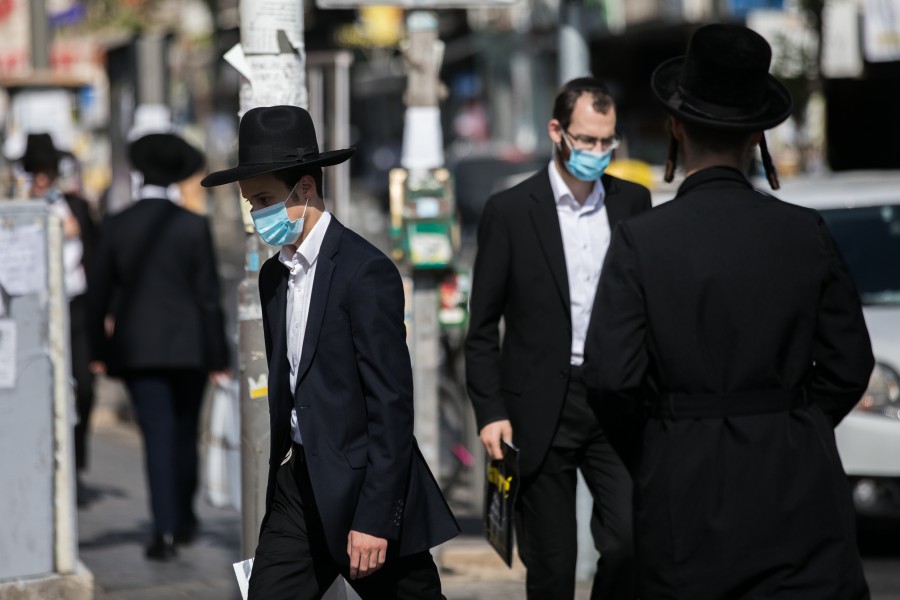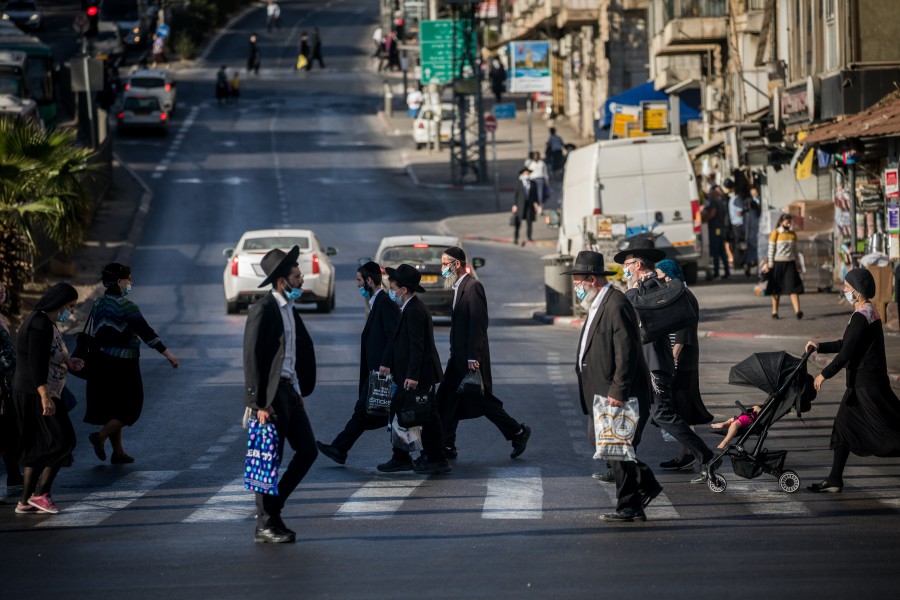First Look: "We Developed a Model to Predict Illness in Haredi Areas"
What caused the Haredi community to fall ill more than the general public? Is it true that extensive use of public transportation can lead to illness? What is the connection between population density and coronavirus, and what worries the Chair of the Advisory Committee to the National Security Council the most? Nitza Klinar-Kasir, Chair of the Advisory Committee, in a fascinating interview.
 In the circle: Nitza (Kaliner) Kasir (Photo: Nir Selkman)
In the circle: Nitza (Kaliner) Kasir (Photo: Nir Selkman)"Elad, Ashdod, Baqa al-Gharbiya, Beit Shemesh, Beitar Illit, Bnei Brak, Modiin Illit, Sakhnin, Petah Tikva, Rekhasim, Shfaram..." Nitza Kasir-Katsir, Chair of the Advisory Committee to the National Security Council, and in her other role - Deputy Chair of the Haredi Institute for Policy Research, lists the names of the cities one after another, defining them with the severe definition: "These are localities where high morbidity is expected in the next wave of coronavirus, with the risk being over 90%".
Unlike other professionals who rely on apparent infection data, Klinar-Kasir chooses to base her determination on a different and unique differential geographic model, which considers not only morbidity indicators but also examines the density indicators of each area in combination with an in-depth analysis of its demographic, economic, and social characteristics. "For months we have been working on this development, and now it seems we have succeeded in building a predictive model that can help decision-makers and implementers in predicting high-risk areas for disease," she announces.
Klinar-Kasir directs the word 'we succeeded' towards herself and the other members of the advisory committee, who come from diverse government ministries, alongside representatives from bodies such as the CBS and the Bank of Israel, and various professionals, including epidemiologists, economists, and sociologists. They are currently revealing the conclusions from their deep analysis in a special report.
"The purpose of the report is to manage to avoid in advance morbidity that would lead to another nationwide lockdown," she clarifies. "It is clear to us that after two hard lockdown rounds and in the current economic-social reality, it is questionable whether the imposition of a third lockdown on all regions of the country is a sustainable solution".
 (Illustrative photo: Flash 90)
(Illustrative photo: Flash 90)
"I Was Surprised by the Connection Between the Data and Illness"
"For years I dealt with forecasts as part of my senior position at the Bank of Israel," says Klinar-Kasir, "I was exposed to many data on various subjects, and yet I was very surprised during the work we carried out in recent months, revealing to us the close connection between different data and the presence of the coronavirus in areas characterized by these data. These are clear things, almost without exceptions".
According to her, there is a direct connection between high morbidity rates and population density, especially when it exists not only in homes but also in the entire area and even in playgrounds. "We also found a connection between the level of morbidity and the frequency of using public transportation, and between areas with a low socioeconomic ranking and the height of infection rates. But the most amazing thing is that even when we took all the variables we examined and neutralized them, it was found that a high rate of Haredi population, in itself, significantly increases morbidity".
Klinar-Kasir emphasizes the alarming significance: "This is the real reason that although the virus did not skip any of the populations, the Haredi community experienced it more intensely, and in the first wave, for example, it experienced the coronavirus five times more than the rest of the population".
That means the Haredi public is more infected because it is Haredi and not just because of its objective data?
"Exactly so. This is something we did not find in the Arab society, for example, even though technically it sometimes has similar field conditions as the Haredim in terms of density, economic level, etc. The more we researched the subject, we understood how logical it is that specifically the Haredi community would suffer from high morbidity because it is characterized by communal interactions, and this is reflected in many areas of daily life. For illustration: a Haredi person can pray in the morning in a certain quorum, then study in a kollel with several dozen yeshiva students, study in another kollel in the afternoon, and attend a large wedding in the evening. Thus, in one day, he sometimes meets dozens of different people. It is not comparable to an average person in the general public who usually meets only a few work colleagues and his close family members.
"There are many advantages in the Haredi society precisely because of this," she clarifies, "because it is a society very supportive in times of distress, and it also provides a large social fabric. In past data analysis, we saw how high the happiness indexes in the Haredi community are and how relatively low the depression rates are. But therein is also the rub. Because the interaction is so close, it also creates high morbidity levels".
Klinar-Kasir notes another alarming statistic: "In the Haredi society, we see more people economically affected by the coronavirus. Although allowances were not cut, and those who relied on them were not harmed, there is significant harm in donations from abroad, and there are more layoffs, because it is easier for employers to dismiss the weak population, and the Haredi society certainly counts among them".

The Demand: Clear Rules and Goals
"We all as a society have undergone a significant upheaval in recent months," emphasizes Klinar-Kasir, "only that when it comes to the Haredi society, the morbidity rates are much higher".
Do you think there was a certain mistake in management or something we could have done to get through the past few months more successfully?
"Looking back, it is always easy to be wise. I do not think at the beginning of the pandemic, with the sparse data we had, we could have acted differently. Unfortunately, even now, the way of management is not clear enough to us. We do know a little more about the virus, but we still do not know how long the pandemic will stay with us and at what cost it will come, besides the heavy price it has already exacted".
And yet, with a forward-looking perspective, what can you suggest?
"As Chair of the Advisory Committee to the National Security Council, my demand from the state is very firm, and that is after we have reached a point where the public is confused, does not understand the management, and thereby struggles to comply with the guidelines.
"I think clear rules must be established, and goals and metrics should be set according to which the policy will be conducted. After formulating these rules, the data according to which decisions are made should be published transparently so that a simple citizen can also see how many people have been infected recently and understand the exact state we are in - whether the economy is open or closed and what is the state of the education system. People will also be able to know the status of morbidity in the town where they live, and they themselves will understand that if they do not do something to prevent infection, certain measures will be taken against them.
"Of course, alongside transparency and precise guidelines, extensive education and enforcement are required," she emphasizes, "It is forbidden to cause a state of contempt because we are struggling with a disease with terrible implications, and not just in the health field. If we talked earlier about preventive measures to avoid reaching the difficult situation, then it is clear that the earlier we start with the stricter steps, the shorter their duration will be, and if the public cooperates with wearing masks, social distancing, and all other precautions – the damages will be smaller in all respects.
"Today it is also clear to us that it is not enough for the national government to be involved in everything that happens, but there is also a need for direct intervention of each of the authorities, and the statements of Rabbis are very important. We have seen this time and time again in the religious and Haredi public – when Rabbis issued a sweeping instruction, then their students complied with them".
The steps you mentioned are logical and necessary. How do you explain why they are not always implemented in the field?
"Unfortunately, people are mainly focused on themselves. They think about what is happening with them at the moment and find it hard to look at the situation from a broader perspective. For example, they deal with the question 'what will happen to me if I do not meet my family?' and they see in their mind's eye that it is not a big damage. Therefore, they do not understand the importance of adherence to caution. They do not succeed in seeing the implications of their private and personal actions on the entire country. It is difficult for them to understand that if eventually, the entire country behaves like them, we will all reach a third wave and possibly even a lockdown".
Do you really think such a lockdown awaits us around the corner?
"I very much hope we will be saved from a third lockdown, but I am not very optimistic. It is clear to me that the matter also depends on when a vaccine will be found. Meanwhile, it does not seem that the public will succeed in overcoming the virus with only social distancing. Personally, I can tell you that last week I heard about many weddings that took place, despite the prohibition. It is clear that each such event ultimately leads to aggravation, and it does not remain within one family but spreads further and further very rapidly".
 (Illustrative photo: Flash 90)
(Illustrative photo: Flash 90)Finally, what do you think awaits on the day after the coronavirus? Will something in the Haredi public experience change?
"I am sure that we will see significant changes in the Haredi society the day after. First of all, there will be a large economic change. Past experience, as well as first signs from the current crisis, indicate that the weaker populations in the labor market, including the Haredi community, are hit harder than others. Moreover, when examining the unemployment rates, it turns out that not only is the damage to these populations harder, but the recovery time from the crisis may be significantly longer. The state will probably be able to help less, because we are currently in a very large deficit, and there is a limit to the assistance the state can provide.
"On the other hand, I am sure we are about to see the integration of Haredim in the labor market. We can learn from the crisis at the beginning of the millennium, which led directly to a change in the Haredi society and its significant integration in the labor market. For comparison: Haredi women today are employed almost like Jewish women in the general sector. They are also integrated almost like women in OECD countries, despite the fertility rate in the Haredi population being 7.1 while in OECD countries it is exactly the opposite – 1.7. I am sure we will continue to see a significant and dramatic change concerning women's employment. Another statistic we saw in the millennium crisis is that people sought different professional alternatives and many of them became self-employed. I am sure this is a process that will be even more visible in the Haredi sector".
But there is one thing that truly worries Klinar-Kasir: "I am sure that after this crisis we are about to see unparalleled polarization between the Haredi and the general public. It is a social explosion that could affect our social and national resilience. Just recently, I used a professional tool to find online how many incitement statements there were in one day, and I was horrified. These numbers cannot be compared to what was in the past, and it is present on both sides. It is said that it is easy to destroy, but much harder to build".

